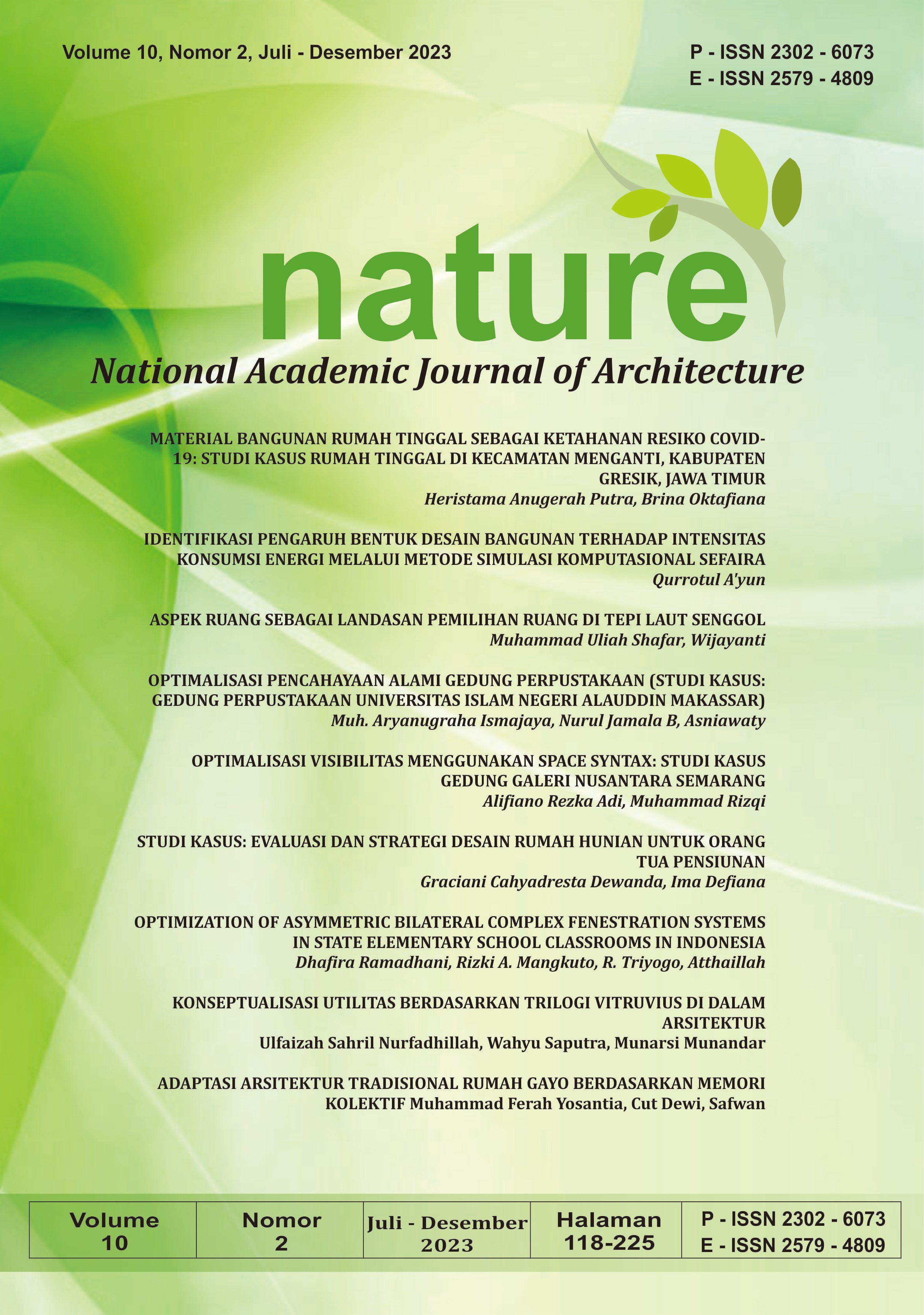IDENTIFIKASI PENGARUH BENTUK DESAIN BANGUNAN TERHADAP INTENSITAS KONSUMSI ENERGI MELALUI METODE SIMULASI KOMPUTASIONAL SEFAIRA
Abstract
Currently, architectural items need to be energy efficient in addition to being aesthetically pleasing and practical. Residential or residential-type objects are not exempt. Residential buildings need to be kept at comfortable temperatures and with appropriate lighting while also being mindful of their energy usage. The importance of energy usage in building design depends on several aspects. These include the building's orientation, the material of the building envelope, the shape of the window, and the building plan and room volume. In order to attain the Energy Consumption Intensity (IKE) value required by the 2012 Regulations of the Ministry of Education and Culture and the Ministry of Energy and Mineral Resources, a suitable form of building design is therefore necessary. Performance-Based Design is one method that could be used to address this issue. A design methodology known as "performance-based design" takes into account each architectural element's performance. One piece of performance-based design software is Sefaira. To simulate energy use in a design, one must first enter building element and climate data into Sefaira. According to the research findings, a building design is considered efficient with an IKE if it satisfies the following criteria: (1) the building's geometric shape leads to a curved shape or has many sides; (2) the building's proportions are the same or, if it is slightly elongated, it is oriented towards the west and east; (3) the building reduces the amount of glazing material coverings; and (4) the building uses external Venetian shading.
Downloads
References
Abdurrahman Rabbani, B., & Cahyani, D. (2019). Energy Optimization on Preliminary Design of The Botani Museum using Sefaira® Thermal Comfort Standard for Open Space in Hot-Humid Climate View project. In International Journal of Engineering and Advanced Technology (IJEAT) (Issue 5). https://www.archdaily.com/775426/nanjing-hongfeng-technology-park-building-a1-one-design
Alhamnovanda, S., Purnomo, A. B., Siswanto, J., Program, ), Fakultas, S. A., Sipil, T., Perencanaan, D., & Trisakti, U. (2019). Optimalisasi Penerapan Efesiensi Energi pada Fasad Perpustakaan Nasional. In Seminar Nasional Cendekiawan ke (Vol. 5).
Amalia, M., Paramita, B., Minggra, R., & Koerniawan, M. D. (2020). Efficiency Energy on Office Building in South Jakarta. IOP Conference Series: Earth and Environmental Science, 520(1), 012022. https://doi.org/10.1088/1755-1315/520/1/012022
Dimas. Tubagus A., Fitria, D., & Junus D, T. (2011). Perbandingan Perhitungan OTTV dan ETTV Gedung Komersial - Kantor.
Goswami, D. Y., & Kreith, F. (2007). Handbook of Energy Efficiency and Renewable Energy (D. Y. Goswami & F. Kreith, Eds.). CRC Press. https://doi.org/10.1201/9781420003482
Handayani, T. (2010). Efisiensi Energi dalam Rancangan Bangunan Energy Efficiency in Building Design (Vol. 1, Issue 2).
Hanissaa, A. N., & Paramita, B. (2021). Sefaira Simulation in Residential Houses to Determine the Energy Use of Wall Materials. IOP Conference Series: Earth and Environmental Science, 738(1), 012017. https://doi.org/10.1088/1755-1315/738/1/012017
Hanum, M., & Murod, C. (2011). Efisiensi Energi Pada “Smart Building” Untuk Arsitektur Masa Depan.
Harrell, C. R., & Price, R. N. (2003). Simulation modeling using ProModel technology. Proceedings of the 2003 International Conference on Machine Learning and Cybernetics (IEEE Cat. No.03EX693), 175–181. https://doi.org/10.1109/WSC.2003.1261421
Karyono, T. H. (2016). Arsitektur Tropis dan Bangunan Hemat Energi. In Universitas Tarumanagara (Vol. 1, Issue 1).
Laksmiyanti, D. P. E. (2016). Kinerja Bentuk Bangunan Perkantoran Bertingkat Menengah di Surabaya terhadap Efisiensi Energi Pendinginan. Jurnal IPTEK, 20(1), 1. https://doi.org/10.31284/j.iptek.2016.v20i1.16
Menteri, E. (2012). Peraturan Menteri ESDM Nomor 13 Tahun 2012 tentang Penghematan Pemakaian Tenaga Listrik. www.djpp.depkumham.go.id
Milianingrum, T. H. (2015). Optimalisasi Pencahayaan Alami dalam Efisiensi Energi di Perpustakaan UGM.
Nabilah, A., Devita, H. P., Halen, Y. Van, & Jurizat, A. (2021). Energy Efficiency in Church Building Based on Sefaira Energy Use Intensity Standard. IOP Conference Series: Earth and Environmental Science, 738(1), 012013. https://doi.org/10.1088/1755-1315/738/1/012013
Octarino, C. N., & Feriadi, H. (2021). Evaluasi Kinerja Selubung Bangunan Gedung Agape Universitas Kristen Duta Wacana Yogyakarta. Langkau Betang: Jurnal Arsitektur, 8(2), 86. https://doi.org/10.26418/lantang.v8i2.45436
Putra, R. A. (2018). Peran Teknologi Digital dalam Perkembangan Dunia Perancangan Arsitektur. In Elkawnie: Journal of Islamic Science and Technology (Vol. 4, Issue 1). www.jurnal.ar-raniry.com/index.php/elkawnie
Santoso, E. I. (2012). Kenyamanan Termal Indoor pada Bangunan di Daerah Beriklim Tropis Lembab.
Sidik, A. F., Paramita, B., & Busono, T. (2021). The Comparison of Energy Usage of Modular Housing using Sefaira®. IOP Conference Series: Earth and Environmental Science, 738(1), 012019. https://doi.org/10.1088/1755-1315/738/1/012019
Wibawa, B. A., Saraswati, R. S., Chandra, A. B., & Saputro, B. E. (2021). Energy Optimization on Campus Building Using Sefaira. IOP Conference Series: Earth and Environmental Science, 738(1), 012015. https://doi.org/10.1088/1755-1315/738/1/012015
Copyright (c) 2023 Qurrotul A'yun

This work is licensed under a Creative Commons Attribution-ShareAlike 4.0 International License.
By submitting your manuscript to our journal, you are following Copyright and License











